
Beyond Brushstrokes
By Maria Victoria Rufino

The spirit of creative genius is in every work. An artwork is a child of the mind or the spirit. The artist is a mortal human being, but a good artwork is immortal.
Woody Allen, the witty comedic actor, film director and producer, commented dryly, “I don’t want to achieve immortality through my work… I want to achieve it by not dying.” Greek physician Hippocrates (c. 440 BC – 377 BC) once wrote, “Life is short, but art is long.”
Every successful individual – in politics, education, business, science, the arts — desires recognition. The scientist and inventor, for example, work persistently and intensely to discover the “eureka” formula and “aha” gadget that would make a lasting impact on the world.
Many politicians use public infrastructure — airports, bridges, monuments, highways, dams, town halls and cities — to achieve fame. Their faces and names are emblazoned on billboards at the construction site. Although public funds are used, they claim credit for the projects. It is a not-so-subtle hint to the potential new voters. For name and face recall.
Endowments from private or corporate foundations are given to universities and schools, which often name buildings after them as a way of honoring the illustrious alumni. In some cases, ego gratification is the motive of donors who are not alumni of that school.
Sponsors for specific disciplines and research donate professorial chairs, classrooms, auditoriums, libraries and chapels. This is the best way to help the institution and support dedicated professors who need adequate compensation and upgrade the education programs.
Skyscrapers, elite clubs, headquarters, and churches have plaques engraved with the names of the founders, directors, and charter members. Almost every street, road, highway, and lane is named after a hero, a famous individual, or a pseudo-celebrity. There are just too many new street names that change as a result of having more people to honor than streets. No wonder people get lost in our city. (The signage is not clear in some parts.)
There are special exceptions that truly deserve credit, such as those in old European capitals. For example, the Florentine families that dominated the Renaissance period in the 15th century, such as the Medici family — bankers, aristocrats — who were the most important art patrons and benefactors. Six centuries later, Florence is still a center of the arts, with every piazza, church, and open space filled with precious artworks, public monuments, private sculptures and paintings, thanks to patrons. The Uffizi Gallery holds a vast trove of paintings by the masters — Leonardo, Michelangelo, Raffaello — again thanks to patrons.
Venice and Milan and, of course, Rome are also filled with works so grand and impressive. The Vatican has the Sistine Chapel with Michelangelo’s breathtaking murals and frescoes — Genesis and The Last Judgment. Emperors, kings and the Church financed the magnificent monuments and sculptures, among them La Pieta and Moses. It was the patrons’ collective vision to preserve the artistic spirit of the era.
Behind the grand gesture was the egoistic desire to perpetuate themselves as great cultural and historical icons.
Through the centuries, the practice has continued in different countries and in diverse ways.
In the Philippines, we can be proud of our stunning structures — historic churches and cathedrals. There are marvelous pre-war buildings designed and built in Manila such as the Post Office (that was burned recently and is being rebuilt), the old Senate building that is now the National Museum of Fine Arts, and two other buildings in the complex, the National Museum of Natural History and National Museum of Anthropology.
But in recent years, the practice of naming buildings, airports, streets, and public spaces has been taken to the extreme. Some publicity-conscious personalities want their images or busts and plaques displayed.
The worst ego-boosting visual pollutants are the distracting, unsightly billboards that sprout along the highways.
Are these commercial monstrosities going to be our pathetic form of public art? Just asking…
On a lighter note, there was a recent exhibition of contemporary art and a live event which were a collaboration between French and Filipino artists KATRE, NEBAY, QUICCS, TRIP63. Called NOW SPRAYING, it was spearheaded by the Metropolitan Museum (a.k.a. The M) in BGC and the Embassy of France, and was a fun, creative form of expression to embellish the exterior of the museum building. That was a delightful afternoon event for the spectators and the public.
Bravo, Ambassador Marie Fontanel and Cultural Counsellor Marc Piton of the Embassy of France and The M president Tina Colayco!
Maria Victoria Rufino is an artist, writer and businesswoman. She is president and executive producer of Maverick Productions.